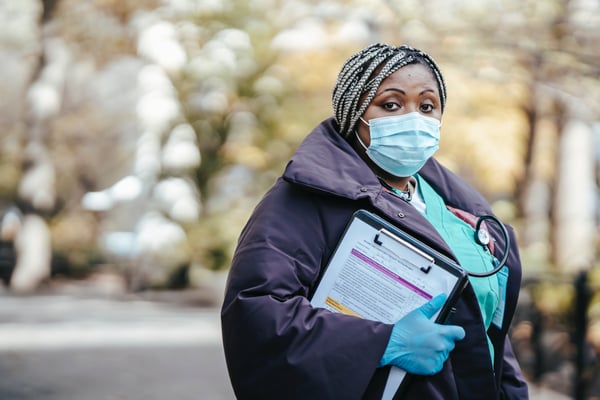Travel wages continually fluctuate, often based on supply and demand. This trend was especially apparent during the height of the COVID-19 pandemic when travel nurse wages soared beyond travelers’ wildest dreams and prompted many staff nurses to hit the road for the first time. As the pandemic waned and extra funding to pay for travel staff dried up, hefty healthcare travel pay began a steep descent.
However, it’s unlikely that travel wages will fall below pre-pandemic amounts. Healthcare facilities around the nation continue to grapple with staffing shortages made worse by many factors, including some perm staff deciding not to return and other healthcare professionals leaving the profession altogether following their years-long battle with coronavirus. For those still traveling, a marked difference in wage trends occurred in October, boosting many paychecks.

Travel Wages Make a Comeback
After witnessing a mostly downward spiral in travel wages over the first nine months of 2022, October saw a distinct uptick in healthcare travel pay in over half the states. Let’s recap the numbers for the first three-quarters of the year to visualize the complete about-face better.
|
Month |
# States With Increased Pay |
Largest Increase |
# States with Decreased Pay |
Largest Decrease |
# Remained the Same |
|
1 |
3.3% |
38 |
-15.4% |
11 |
|
|
5 |
3.0% |
38 |
-22.9% |
7 |
|
|
0 |
N/A |
43 |
-14.3% |
7 |
|
|
7 |
3.6% |
27 |
-19.2% |
16 |
|
|
5 |
3.1% |
36 |
-12.4% |
9 |
|
|
1 |
1.3% |
48 |
-17.3% |
1 |
|
|
0 |
N/A |
50 |
-24.4% |
0 |
|
|
6 |
6.1% |
32 |
-10.5% |
12 |
|
|
43 |
11.1% |
3 |
-3.7% |
4 |
States with Wage Increases
For the first time since January, healthcare travel wage trends indicated that the states with increases in October hit double digits. A total of 29 states posted higher travel wages compared to September, ranging between 1% and 22.9%. The top five states had the largest increases of the entire year, including in January, when the biggest boost in pay was 11.1%.
Delaware had the highest increase of all states at 22.9%. In contrast, the state had a 10.5% drop in travel wages in September, a 16.3% decrease in August and a 6.4% dip in July. The state hadn’t posted a bump in healthcare travel pay since June, when wages went up 3.6%.
|
State |
Avg Weekly Pay September |
Avg Weekly Pay October |
Percent Increase |
|
Delaware |
$2,020 |
$2,619 |
22.9% |
|
Rhode Island |
$2,166 |
$2,619 |
17.3% |
|
Maryland |
$2,220 |
$2,601 |
14.6% |
|
Massachusetts |
$2,449 |
$2,836 |
13.7% |
|
Connecticut |
$2,308 |
$2,613 |
11.7% |
|
New Hampshire |
$2,348 |
$2,641 |
11.1% |
|
Wisconsin |
$2,351 |
$2,537 |
7.3% |
|
Pennsylvania |
$2,587 |
$2,751 |
6.0% |
|
New Mexico |
$2,474 |
$2,596 |
4.7% |
|
Missouri |
$2,228 |
$2,330 |
4.4% |
|
New Jersey |
$2,902 |
$3,005 |
3.4% |
|
Arkansas |
$2,338 |
$2,414 |
3.2% |
|
Vermont |
$2,696 |
$2,766 |
2.5% |
|
Oklahoma |
$2,128 |
$2,180 |
2.4% |
|
Minnesota |
$2,734 |
$2,796 |
2.2% |
|
West Virginia |
$2,683 |
$2,740 |
2.1% |
|
Colorado |
$2,457 |
$2,507 |
2.0% |
|
Alabama |
$2,299 |
$2,341 |
1.8% |
|
North Carolina |
$2,534 |
$2,577 |
1.7% |
|
Wyoming |
$2,868 |
$2,916 |
1.7% |
|
South Dakota |
$2,675 |
$2,720 |
1.6% |
|
Kentucky |
$2,613 |
$2,656 |
1.6% |
|
Michigan |
$2,505 |
$2,545 |
1.6% |
|
Texas |
$2,131 |
$2,165 |
1.6% |
|
Hawaii |
$2,595 |
$2,634 |
1.5% |
|
Maine |
$2,689 |
$2,729 |
1.5% |
|
Ohio |
$2,660 |
$2,697 |
1.4% |
|
California |
$3,059 |
$3,099 |
1.3% |
|
Mississippi |
$2,309 |
$2,332 |
1.0% |
States with Wage Decreases
Only five states recorded a drop in healthcare travel wages in October, and those were relatively minimal, ranging between 1.2% and 2.6%. Louisiana had the largest decrease after staying relatively the same in September, with a 0.1% dip. However, the state posted more significant drops of 5.1% in August and 3.8% in July. The last time Louisiana had an increase was in January, and it was only 0.6%.
|
State |
Avg Weekly Pay September |
Avg Weekly Pay October |
Percent Increase |
|
Louisiana |
$2,390 |
$2,330 |
-2.6% |
|
Kansas |
$2,298 |
$2,249 |
-2.2% |
|
Oregon |
$2,757 |
$2,704 |
-2.0% |
|
Iowa |
$2,644 |
$2,608 |
-1.4% |
|
Florida |
$2,034 |
$2,010 |
-1.2% |
States That Stayed the Same
Healthcare travel wages in the remaining 16 states stayed relatively the same, meaning they didn’t increase or decrease by at least 1%. Five posted minimal increases between 0.4% and 0.9%, and 10 had minimal decreases between -0.2% and -0.9%. Idaho literally had a change of 0%, with the average weekly pay remaining steady at $2,549.
|
State |
Avg Weekly Pay September |
Avg Weekly Pay October |
Percent Increase |
|
Washington |
$2,731 |
$2,756 |
0.9% |
|
New York |
$2,789 |
$2,811 |
0.8% |
|
Nevada |
$2,832 |
$2,851 |
0.7% |
|
Illinois |
$2,717 |
$2,729 |
0.4% |
|
Tennessee |
$2,309 |
$2,317 |
0.4% |
|
Idaho |
$2,549 |
$2,549 |
0.0% |
|
Nebraska |
$2,671 |
$2,666 |
-0.2% |
|
Utah |
$2,331 |
$2,327 |
-0.2% |
|
South Carolina |
$2,361 |
$2,352 |
-0.4% |
|
North Dakota |
$2,915 |
$2,900 |
-0.5% |
|
Arizona |
$2,668 |
$2,652 |
-0.6% |
|
Montana |
$2,485 |
$2,469 |
-0.6% |
|
Virginia |
$2,504 |
$2,485 |
-0.8% |
|
Alaska |
$2,761 |
$2,740 |
-0.8% |
|
Indiana |
$2,654 |
$2,632 |
-0.8% |
|
Georgia |
$2,331 |
$2,309 |
-0.9% |
Potential Reasons for the Flip
Fluctuating travel wages occur for many reasons, sometimes for no apparent reason, making it challenging to determine the cause. However, large flips, such as those between September and October, usually stem from some underlying issue.
In October, it’s possible that a combination of causes occurring simultaneously boosted wages. Starting with the ongoing nursing shortages felt nationwide. Another potential impact was the rising number of several respiratory illnesses.
According to the Centers for Disease Control and Prevention (CDC), seasonal influence activity continued to increase nationwide during the week ending October 29, 2022 (Week 43). However, the southwestern and south-central areas of the United States reported the highest activity levels, followed by the Mid-Atlantic and the south-central West Coast regions.
Hospitals admitted 4,326 patients with influenza nationwide during this week, and the percentage of specimens tested for influenza increased nationwide. Since the beginning of the 2022 flu season, the CDC estimates at least 1.6 million illnesses, 13,000 hospitalizations and 730 deaths, and the season isn’t even in full swing yet. However, the cumulative hospitalization rate for week 43 was higher in 2022 than in every previous year since 2010.
Adding to the mix, the CDC’s Respiratory Syncytial Virus (RSV) Surveillance indicates that positive RSV tests began spiking about mid-September and have increased every week since. The CDC’s COVID Data Tracker also shows that a few hotspots still exist across the country with continued coronavirus flare-ups. The daily average of new COVID-related hospital admissions was 20,913 nationwide by the first week of November.
When you combine all these respiratory illnesses and rising hospitalization rates, it becomes more apparent why 29 states reported increased travel wages for October. But you should also factor in the number of hospitals and health systems cutting their workforce due to financial and operational challenges.
While job cuts at hospitals may seem counterproductive based on the ongoing and widely publicized shortages of nurses and other healthcare professionals, many facilities are taking this tact. These cuts potentially leave an even slimmer staff available to treat the increasing number of patients.
You may have also recently heard news stories about hospitals shutting down units or health systems closing entire facilities. When one hospital’s emergency room closes, the patient load at nearby facilities rises. These facilities may not have enough staff and turn to temporary workers until they hire more. Many rural hospitals are also at risk of closure in the near future, ultimately funneling more patients to the closest, potentially understaffed, healthcare facility.
Considering these factors, and possibly many other less publicized issues, the demand for travel workers hasn’t declined. Although previous drops in healthcare travel wages mean the current pay is much lower than when COVID filled ICUs nationwide, it’s still higher than pre-pandemic wages and filling gaps in staffing gaps continues to be challenging for many.
Schedule a demo with Vivian Health to learn how we can help you meet your hiring goals.
